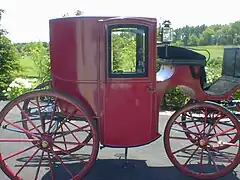

A brougham[note 1] was a light, four-wheeled horse-drawn carriage built in the 19th century.[2][note 2] It was named after the politician and jurist Lord Brougham, who had this type of carriage built to his specification by London coachbuilder Robinson & Cook[2] in 1838 or 1839.[2][3] It had an enclosed body with two doors,[2] like the rear section of a coach; it sat two, sometimes with an extra pair of fold-away seats in the front corners,[3] and with a box seat in front for the driver and a footman or passenger. Unlike a coach, the carriage had a glazed front window, so that the occupants could see forward.[2] The forewheels were capable of turning sharply. A variant, called a brougham-landaulet, had a top collapsible from the rear doors backward.[note 3]
Four features specific to the Brougham were:
- the absence of a perch - the spring hangers were mounted directly to the body structure, saving weight and lowering the floor, to ease entry
- the sharply squared end of the roof at the back,
- the body line curving forward at the base of the enclosure, and
- low entry to the enclosure, using only one outside step below the door.[2]
In popular culture
Broughams are a common means of transport in the Sherlock Holmes stories.
The Picture of Dorian Gray by Oscar Wilde mentions the brougham alongside a number of other carriage vehicles of the era, such as the omnibus, the hansom cab, the four-in-hand, and the victoria.
In L. P. Hartley's novel The Go Between a brougham is sent to fetch the character Marian (chapter 23, p.274 [1st ed.]).
In the book The Alienist by Caleb Carr, a frequently used mode of transportation for the characters is a brougham.
In Rudyard Kipling's poem "The Mary Gloster", the dying Sir Anthony complains bitterly to his son about never seeing "the doctor's trusty brougham to help the missus unload" – a reference to the effete Dickie's childless marriage and hence the extinction of his family.
In the novel The Crimson Petal and the White, by Michel Faber, William Rackham purchases a brougham as a surprise gift for his wife, Agnes Rackham, with the help of his beautiful mistress, a former prostitute known as Sugar.
See also
- Brougham (car body), inspired by the brougham carriage
- Clarence (carriage), larger version of the Brougham
- Landaulet, (landaulette in British English) car body style inspired by the landaulet carriage
- Carriage
- Horse-drawn vehicle
Footnotes
Notes
- ↑ "brougham". Oxford English Dictionary (Online ed.). Oxford University Press. (Subscription or participating institution membership required.)
- 1 2 3 4 5 6 Haajanen 2003, p. 24.
- 1 2 Stratton 1878, p. 376.
References
- Haajanen, Lennart W. (2003). "1Brougham". Illustrated Dictionary of Automobile Body Styles. Illustrations by Bertil Nydén; foreword by Karl Ludvigsen. Jefferson, NC USA: McFarland. pp. 24–25. ISBN 0-7864-1276-3. LCCN 2002014546.
- Stratton, Ezra (1878). World on Wheels. New York: Bloom. ISBN 0-405-09006-4. Retrieved 4 September 2014.
External links
- 1871 Advertisement for William Kilross & Sons and Kinross Brougham Illustrations and text
- CAAOnline: Carriage Tour Carriage Association of America. Illustration and text
- Horse Drawn Brougham, The Henry Ford. Henry Ford Museum, Dearborn, Michigan. Photo and text.
- The Long Island Museum of American Art, History & Carriages, Stony Brook, New York: Collection Database. Search brougham; illustrations and text.
- Victorian Brougham carriage and The Victorian Brougham at the Institute of Texan Cultures TTM web. Texas Transportation Museum, San Antonio. Photos
- Articles about Horse-drawn Carriages